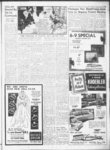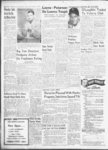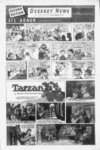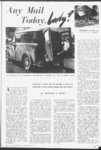| OCR Text |
Show ' ; - - . ' intrh, 1" v t - .bot ,r ''' imr,e, ; " - '4 3 ' ,, lirmmemeeemmmetem.,,, Af -..., ., ' i ie ,i,.., , : ,,o,,,,,...filik,,w,, ItimosikomilioNammosismomommoliswei '- , , ' I l 1) The , A 1 i ., 11I b ,, tt, " , !' . - 0 t l. , t k , t, i , : i, 4--' ..t,,..we . . , - , ; , . ) . , .1 -- ''' - ia ,,,,,0040-N- ' . .. - - , t ...--- ' ' ''.'s e ,, ;,- - i ,, . , 4, ,' : 1,, ...0,C, ,, , e,'y , I, , ,.. .,,, 4 ' - e .. - -- , 7 , f , . - . , , . , , . , - - . , . i ',-- ,, " - , . " k - ,PRIP---1 . - - , I - ,. e,,. I , .., - '' t - 4 .., , ' d, : , ' . , .,. ' , ,47.1. 4 o' ' - 1,,:Noimr----04- , ' . 1 I- ,- 4 - ., 4 ''..., vo S U Army Photo By RAY McGUIRE a research laboratory in upstate New York four years ago. a young was experimenting with an artificial "cloud" formed by breathing into a freezer temg chest operating at peratures. It was a hot day and the chest interior was not as cold as he desired, so the scientist opened the freezer lid and dropped in a block of ordinary mN below-freezin- dry ice. Suddenly the miniature "cloud" became agitated, and before the surprised eyes of the researcher, small snowflakes began to form and drop to the floor of the chest. The erstwhile machinist, Vincent J. Schaefer of General Electric Corporation's research staff, had accidentally produced the e snow storm. first During the four years that have elapsed since that discovery, which some day may rank alongside the discovery of atomic energy as a scientific achievement, the ,clouds that form above the mountains and valleys of the West have beenpelted with a varietyof objects and chemicals. And there has evolved a new strain of energetic' optimists who seek to demonstrate that the time has come when man can do something 'about the weather. These devotees of the new enthusiasm for tampering with the .. clouds,' are called' "Rainmakers." Like the snake dancers and other medicine men of the . Southwest Indians, the modern "rainmakers" are called upon to work with magic whenever drolith threatens. When New York City's reservoirs were empty, the city fathers banned car washing and Tuesday baths, but they also hired a rainmaker at WO a day, Today Gotham's reservoirs are full. Even the- Navahos were favorably impressed by the big medicine that can be worked by the rain makers of the atomic age. When the South-west- 's worst drotith in years threat., ened extinction of the Indian's wool Man-mad- ' - - industry this summer, the Navaho tribal council plunked down $10,000 for three months of cloud seeding above the reservation's grazing lands. It's still too early to know the results of this resort to the white man's magic, but it's clear that the Southwest Indians have lost faith in their snake dancers and medicine men when it comes to ending a drouth. "RainWhat about these makers"? Can they really make it rain? How do they change the weather? How far will they go? These and many other questions are being asked these days as the ubiquitous rainmakers ply their mysterious trade at a variety of places in the Mountain West. In New Mexico, large-scaexperiments are still being carried on by the civilian and military scientists engaged in "Operation Cirrus." In Idaho rainmaking in reverse has been used in experiments at breaking up thunderstorms which forbring devastating lightning-cause- d est fires. Similar techniques have been used in.the Northwest to prevent hail damage to fruit crops. Wheat ranch.- ers in Colorado have pooled finances to try to produce rain for parched farm lands, and power companies have sprayed dry ice pellets from airplanes to help fill reservoirs. These activities by businessmen. individuals, and government 'agencies all indicate that rainmaking already has a dollars and cents value. And one of the country's top meteorologists is willing to risk his professional reputation on a claim that he can.increase the precipitation in nearly any given area from 50 to 100 per cent by existing methods of rainmaking, or to be more accurate, "rain increasing." Against these optimistic endorsements is arrayed the "show me" attitude of the weather bureau, and conservative meteorologists. While admitting, that cloud seeding has important possibilities, Chief F. W. Reichelderfer of the Weather bureau makes this flat statement: "The droplets in a subcooled cloud are readily converted to 'snow' by sprinkling with dry ice, silver iodide, or other suitable hydro-electr- ic ed le - - Auir'l ,0,4 - 41, jt,' t''':.' 14, 'dr 44, 0 l'Z' 04'4 ) : - '' ro104 t (fir 11 Nriti4riAl N 14 N' tlot .L14;2; .4 , ! 0,-- - tt. le t t,-,r-, . :L i --'' - re7,14 , lik, ?, 7.' ,,, ' A: ,getit - I soil-gougi- 1 4t4IL 1; I sI,.z . - ,,, , , I - f1.1 0 au. , . I, It,,' l''''....d. I t' '''''.- t,. " '1i0p5,7A1 !, n . ' ';, . this fanfare and controversy, it is difficult to assess the potential value of meteorlogy's hottest postwar development But this appears justified: Despite the relatively insignificant time and research devoted to artificial production of rain, scientists have demonstrated that moisture can be wrung out of a cloud which otherwise might not have produced any precipitation. Several years of research and experimentation may be necessary to arrive at sound estimates and procedures, but it appears clear that the rainmakers can profoundly affect the lives and economic future of many of us now living in the Mountain West. The hard facts of geography underline the Mountain West's interest in rainmaking. The vast bulk of America's desert countryland where the annual rainfall is less than 10 inches lies within the mountain states. In fact, except for the tall mountains which rear up to trap moisture and store it up in the snowpack and in underground channels this area is one vast Sahara without moisture enough to support a single running stream of water during the summer months Much of Utah' s land surface is arid or semi-ari- d desert, of use Mainly for winter grazing of livestock. Available water for culinary and industrial needs is the major limiting factor for the growth of every community in this area. Water is our single greatest need to survive and expand. Lack of water is one motivating factor behind this area's interest in rainmaking Too much water at the wrong time is another. Soil erosion and flood damage' from heavy summer storms and cloudbursts are problems nearly everywhere in this area. If the rainmakers can really alter the pattern of precipitation, as they claim to, producing a number of light, regular storms where summer precipitation had been limited to a few cloudbursts, then a major victory may be scored in the conservation movement to save our topsoil and extend the life of our reservoiri.:,, ,.,........ '.. t . the amount of snow or rain that reaches the ground from thi,, source alone, even with a large cloud. is relatively small, scarcely enough to agent, but - , . I .... sidewalk." l . , , ...e,...,...,,.,,,...,......., . tfi 1 N . ,.............,,, - , 4ii , I IS Can , , , ,, I, lc, 1E ik . it.") - 1 , . - ' ,,,,,,.,, ,.... , ,,, ,,,,, , . . ,, 4 F , , - . FIRST stOge of transformation of water drops to snow looks like this ö SECOND , test stage shows part of the ':cloud" forming in snowflakes. -- . sill' ,.. THIRD stage NIxosformed to "sun MINIS MAGAZINE. SALT LAKE w, CITY. inc Cik Ph0106 entire. cloud by 'ice germs.' 21. 1951 -- II 1 |








































































































